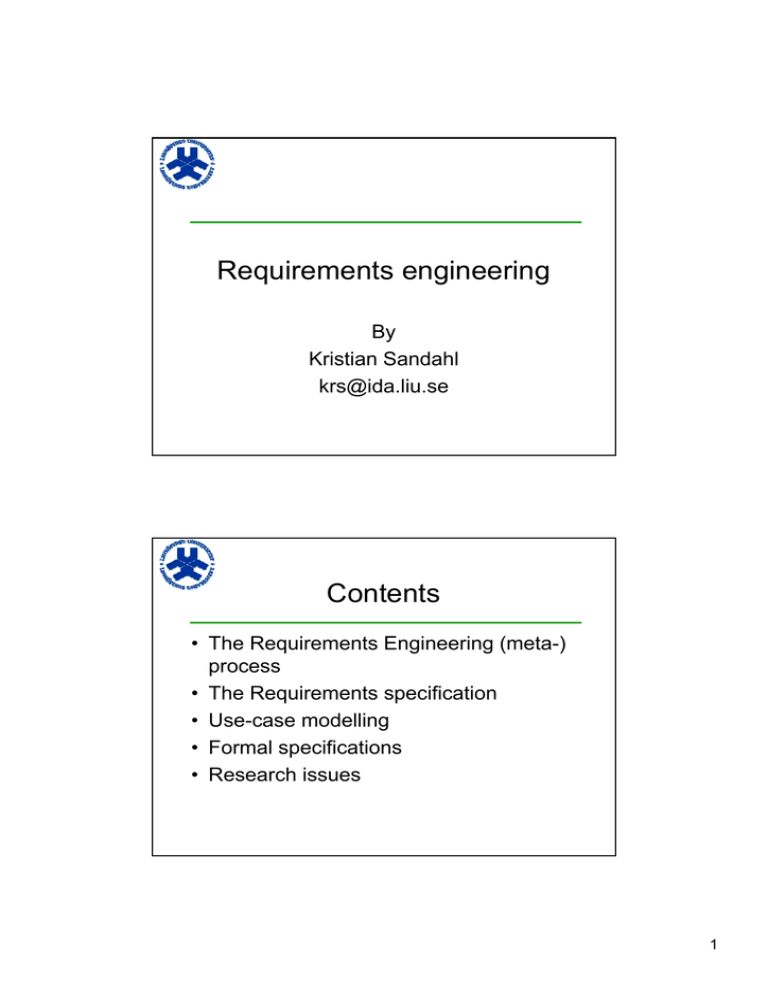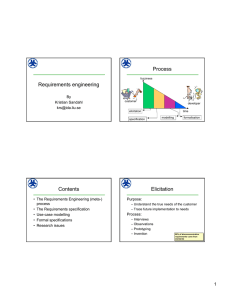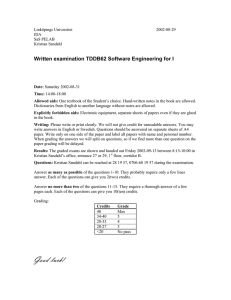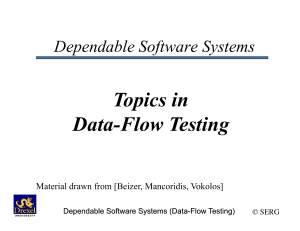Requirements engineering Contents
advertisement

Requirements engineering By Kristian Sandahl krs@ida.liu.se Contents • The Requirements Engineering (meta-) process • The Requirements specification • Use-case modelling • Formal specifications • Research issues 1 Process fuzziness customer developer time elicitation modelling specification formalisation Elicitation Purpose: – Understand the true needs of the customer – Trace future implementation to needs Process: – Interviews – Observations – Prototyping – Invention 80% 80%of oftelecommunication telecommunication requirements requirementscome comefrom from standards standards 2 Interviews Process: • Start • Q&A • Summary teach-back • Thank you! • What’s next Kinds: • Structured • Unstructured Tips • Be 2 interviewers – shift roles • Plan the interview • Don’t stick to the plan – use feelings • Let the customer talk • Prepare ice-breakers • Probe thinking Requirements specification • Requirements are specified in natural, but domain-specific language • Should not consider design solutions • A contract between customer and developer • Starting point for the vendor’s: • developers • testers • tech writers • managers • marketing people • software acquisition people 3 Requirements specification Requirements are: • Numbered • Inspected • Prioritised • Unambiguous • Testable • Complete • Consistent • • • • Traceable Feasible Modifiable Useful for: – – – – – operation maintenance customer developer …. Requirements specification Table of contents 1 Introduction 1.1 Purpose 1.2 Scope 1.3 Definitions, acronyms and abbreviations 1.4 References 1.5 Overview 2 Overall description 2.3 User characteristics 2.4 General constraints 2.5 Assumptions and dependencies 2.6 Lower ambition levels 3 Specific requirements 4 Supporting information 4.1 Index 4.2 Appendices 2.1 Product perspective 2.2 Product functions 4 3 Specific requirements 3.1 Interface requirements 3.1.1 User interfaces 3.1.2 Hardware interfaces 3.1.3 Software interfaces 3.1.4 Communication interfaces 3.2 Functional requirements 3.2.1 Information flows 3.2.2 Process description 3.2.3 Data construct specification 3.2.4 Data dictionary 3.2 Classes 3.2.1 Class1 3.2.1.1 Attributes 3.2.1.2 Functions .... 3.2.n Class n 3.2.n.1 Attributes 3.2.n.2 Functions Modelling • Representation in semi-formal notation • Often diagrammatic representation • Examples: – Object-orientation, use-cases, state-machines – Activity diagrams – Data flow diagrams – Entity-relationship models Requires Requiresaaparadigm paradigm shift shiftto togive givefull full advantage advantage 5 Activity diagram Customer Cashier wait in queue guard decision start [cash] record [card] swimline receive cash record activity draw card give change enter PIN print receipt stop prepare for next customer transition synchronisation bar Formalisation • Represents requirements in a mathematical notation • Interpretation with logic gives possibilities: – Consistency check – Proof of correctness – System simulation – Unambiguity • Examples: Z, VDM, NP-tool,... Requires Requires thorough thorough education education 6 Z example Non-Functional Requirements • NFR bears on the behaviour and quality of the forthcoming soft-ware Case study results: • there seems to be a common understanding about what a NFR is even though more precise wording is needed • it is hard to discover NFRs • it is hard to express NFRs • modern processes, such as RUP, are function-oriented so there is a risk NFR are not prioritised or remembered 7 Validation of requirements • • • • • • • Reading Cross-referencing Interviews Checklists Scenarios Proofs Prototyping Research: Prioritation 1-9 priority 1-9 1-9 x2 0.4 0.2 0.1 cost 8 R1 Research: attribute-driven RE Name Description Origin Realised Models Tasks Planned Context of use User categories Specified Education level Work experience Captured Computer experience Research: release planning Must_have Increases-value Must_have Rel 1 Rel 2 Rel 3 9 Research: continued Swedish Requirements Engineering Research Network SiREN-noder (nodansvarig): •SERG, Lunds Universitet (Dr Björn Regnell) •SERL, Blekinge Tekniska Högskola (Prof. Claes Wohlin) •PELAB, Linköpings Universitet , (Prof. Kristian Sandahl) •ISEE, Högskolan i Skövde, (Dr Anne Persson) •ICS, Kungliga Tekniska Högskolan, (Dr Patrik Forsgren) •SEG, Umeå Universitet, (Dr Jürgen Börstler) http://serg.telecom.lth.se/research/SIREN/ 10






